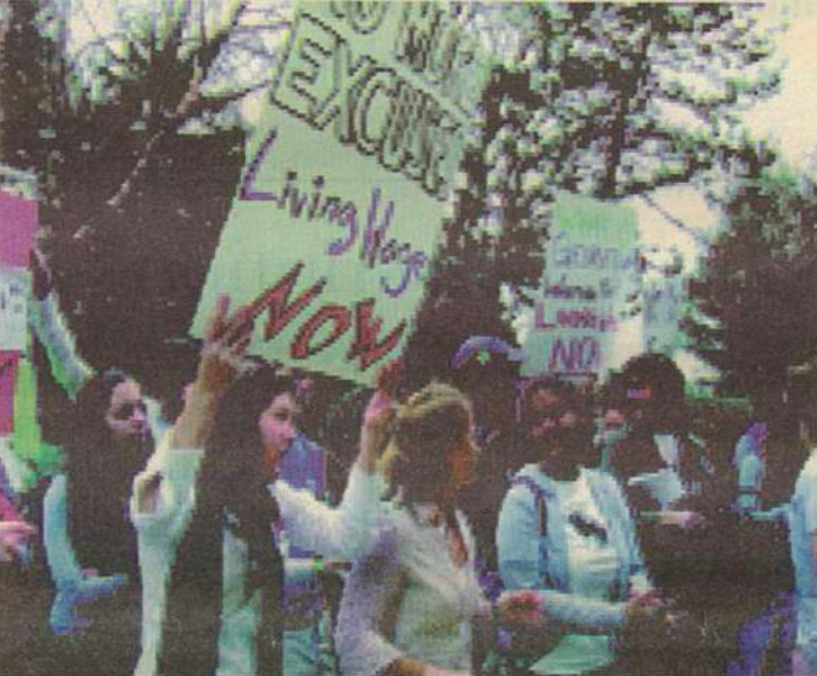For nine days in March, 26 Georgetown University students went hungry to demand a living wage for university employees. Administrators were concerned that parents would blame the school for ailing students; organizers worried that their demands would not be met in time – or at all. The students hoped to bring the same level of urgency to the issue of paying contract workers enough to live on in the District.
“We were warned to stay away from a hunger strike because they aren’t usually successful,” said Rachel Murray, a sophomore who participated in the strike,“ but we just thought that hunger is such a visible thing.”
Both in the Washington area and around the country, students like the ones at Georgetown have teamed with workers and union organizers to add visibility to the living wage issue. Harvard University saw one of the first campaigns in 2001, followed more recently by Yale, Columbia, Georgetown, and the University of Massachusetts at Amherst. In St. Louis, Washington University students led a hunger strike soon after the Georgetown strike.
By getting involved with living wage issues, students have used their unique position to become a driving force in the national debate that has spurred a number of living wage advocacy groups and prompted cities across the country to rethink how they pay their low-wage workers.
Georgetown’s campaign was one of the most successful in terms of requests met. On March 23, the administration announced that it would meet nearly all of the Living Wage Coalition’s demands, raising contract wages to $13 an hour this year and $14 by 2007. After the hunger strike, students have continued their efforts with plans for a national tour of other campuses with similar campaigns and by establishing a n nonprofit organization to unity and strengthen the student groups.
The issue of affordable housing is tied closely to the living wage argument. Maria Rivas, a cleaning woman at the University, illustrates this point. She listed the rising cost of housing as one of her main reasons for taking a second job. The other factors were medications for an elderly parent and groceries.
Michael Stoops, of the National Coalition for the Homeless, said that a full-time job does not guarantee a place to live. “There are people literally on the streets, others always on the brink of ending up homeless. They’re working their tails off to make sure that doesn’t happen,” he said.
It is likely that cases like these led the organization, House the Homeless, to begin a campaign for a Universal Living Wage, stating that such a measure was vital to ending homelessness.
On a national level, the wage issue remains at the level of the minimum wage. In March, bills proposing a minimum wage increase of $1.10 and $2.10 an hour were defeated in the U.S. Senate. Though 12 states have a minimum wage set higher and two have wages set lower, the minimum of 45.15 an hour remains in effect for most of the country. An amount allowing a family to live without public assistance (the basic definition of a living wage) seems far from national consideration.
Groups advocating a living wage often cite numbers. A person working 40 hours a week for 52 weeks a year would earn $10,721 at the minimum wage. According to the economic Policy Institute, a family of one parent and one child living in Washington, D.C., would $37,309 just to cover basic needs. To live in Baltimore, the same family could get by on slightly less –about $28,000 a year. In rural Virginia, a parent and child would need only $23,248, though this is still twice what one would earn at minimum wage.
Those who disagree with wage increases also cite numbers. The Employment Policies Institute concluded from U.S. Census data that only 15% of minimum wage workers are the sole wage earner in a household. The remaining 85% are teenagers, adults living alone, or married adults in a two-income family.
Other critics of raising wages believe that such a move would not effectively alleviate poverty and could create new problems. One argument is that higher earnings would encourage illegal immigration and siphon more revenue from the United States as workers sent money to their home country. Some argue that higher pay would hurt businesses and force layoffs, though many groups cite evidence to the contrary.
At Georgetown, administrators stated that increasing wages as much or as soon as the students and workers asked would cause major budgetary problems and that campus services would suffer.
On the state level, Maryland and Virginia both follow the national rate, while Washington, D.C. maintains a higher minimum of $6.60 to $1 above the national rate, whichever is higher. A bill proposing a minimum wage of $9.50 or $10.50 an hour, depending on benefits, was brought before the D.C. City Council in January. The Council has yet to vote on the measure.
As students have urged colleges and universities to increase employee’ wages, citizens and lawmakers have waged similar campaigns in their cities and counties. Legislators in Washington, D.C.; Arlington and Alexandria, Va.: and Baltimore, Montgomery, and Prince George’s Counties, Md., have all recently taken steps toward such laws. The hourly earnings vary, but the argument remains the same, that $5.15 or $6.15 an hour is not sufficient to support anyone’s basic needs in the Washington area.








